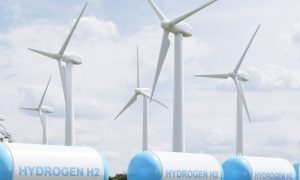Powering India’s future with a green transition

India, the world’s third-largest carbon emitter, is pursuing net-zero emissions by 2070, aiming to mitigate climate change and enhance energy security. With a target of 500 GW renewable energy capacity by 2030, the nation is transitioning to green energy. The ‘India Energy Transition Summit’ highlighted government efforts, including solar energy expansion, biofuel blending, and green hydrogen development.
As a nation with a steep development trajectory, India has experienced significant economic growth in the past few decades, largely fuelled by fossil fuels, making it the world’s third largest carbon-emitter. To combat this problem of carbon-emission, the Indian government has set an ambitious goal of achieving net-zero emissions by 2070.As India transitions towards sustainable energy, this shift will not only help mitigate climate change but also ensure long-term energy security and economic growth. With a target of 500 Gigawatts of renewable energy capacity by 2030, India is taking a leading role in global carbon reduction efforts.The ‘India Energy Transition Summit’, presented by Honeywell and CNBC-TV18, brought together experts, industry leaders from public and private sectors, policy makers to discuss sustainable energy solutions and energy efficient future.
Ashish Modi, President, Honeywell India, set the tone for the summit by emphasising on necessity to tackle CO2 emissions, particularly from hard-to-abate sectors like power and steel, and how it is crucial to meet the net-zero goal India’s Energy Transition Journey.The transition to green energy continues to be a top area of priority for the government, both in terms of bandwidth as well as allocation of government resources. To elucidate, Union Minister for Petroleum and Natural Gas, Hardeep Singh Puri highlighted the government’s commitment to the solar rooftop scheme and the impressive increase in biofuel blending, now at 15.8% from just 1.53% in 2014, making India a leader in biofuels after Brazil. Mr. Puri also pointed out the future potential of green hydrogen, stating the need for large-scale production to reduce costs.
Pralhad Joshi, Minister of New and Renewable Energy and Consumer Affairs and Public Distribution, stressed the importance of reliable energy supplies as India’s energy demands grow and how it has become increasingly important to develop and implement strategies to ensure a reliable and sustainable energy supply.Technology as an EnablerAchieving sustainable energy goals presents a multifaceted challenge that demands a variety of technological solutions. Honeywell stands at the forefront of this effort, leveraging its extensive expertise in automation, energy, and aerospace to drive comprehensive sustainability strategies. Dr Gavin P. Towler, Chief Sustainability Officer at Honeywell, noted that 60% of the company’s research and development budget is focused on sustainability, environmental impact, safety, and societal resilience. The company has reduced its carbon footprints in India by 52% so far and it is on its path to achieve carbon neutrality across all operations by 2035, underscoring its commitment to a sustainable future.
Battery Breakthroughs – Shaping the Future of Energy StorageBattery storage systems are essential for maximizing solar energy potential and its reliable availability. Estimates suggesting a six-fold increase in renewable energy storage capacity is necessary to meet net-zero goals by 2050. Honeywell is proactively addressing this with its Microgrid Battery Energy Storage Solution program and Long Duration Energy Storage solutions. The nation has also been having discussions on building a resilient clean energy supply chain — and efficient battery storage system forms the core for this to facilitate cross border electricity trade. Players like Honeywell can play a vital role in this space by offering a range of battery storage solutions across the country
India has the world’s largest agricultural sector, placing it at a unique vantage point for the development of biofuels. The nation’s vast and diverse agricultural lands, coupled with its rich agricultural heritage, provide a fertile ground for converting biofuel feedstocks such as sugarcane, maize, etc into sustainable energy sources or biofuels. With around 500 million tonnes of biomass generated annually, the government aims to triple sustainable biofuel production by 2030. The rapid scale up can only be possible by deploying multiple SAF pathways which leverage the locally available renewable feedstocks and adoption of hub and spoke models to improve the economy of scale. Producing biofuels provides the farmers and the entire supply chain with additional sources of wealth and job creation thus benefiting the local communities.In Conclusion, India is making significant progress in its energy transition for a sustainable and energy-efficient future. Government-led initiatives, such as the PM Surya Ghar Yojana and expanded biofuel blending, underscore the importance of policy-driven efforts in adopting renewable energy. By leveraging its agricultural potential and embracing green technologies, India stands on the brink of transformative change in the global renewable energy landscape.
Source Link : https://www.forbesindia.com/article/brand-connect/powering-indias-future-with-a-green-transition/94467/1

















